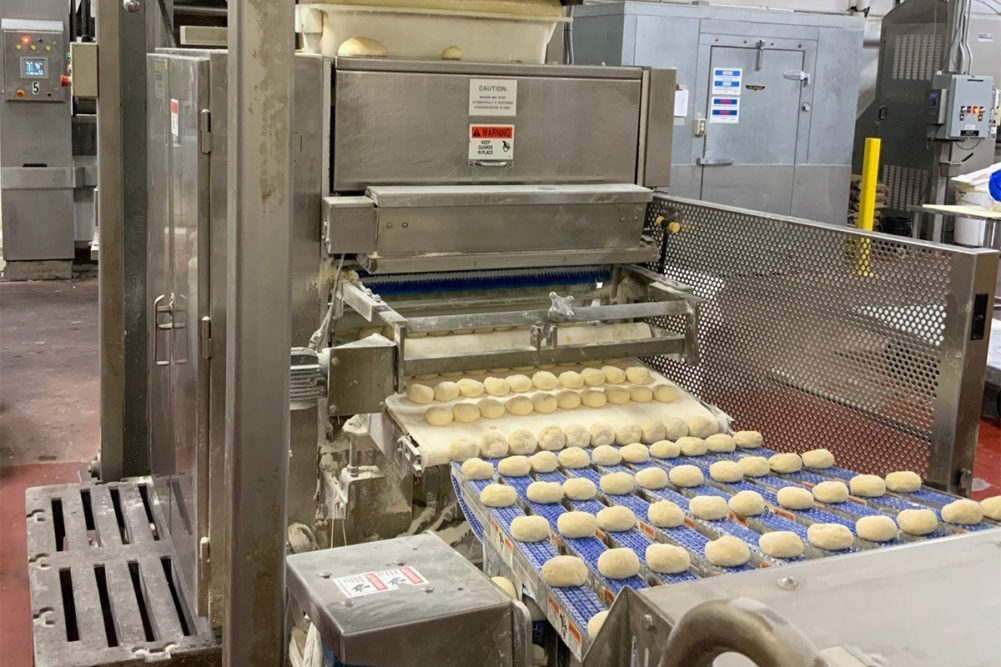High-speed bun and roll production offers a bounty of reward for bakers. The risk of high-speed production is that any breakdown in the line is going to result in catastrophic loss of product before the rest of the process can be halted. Downtime to repair the line also becomes costly, so maintenance becomes even more important for production lines designed to run at high speeds.
“Dedication to preventative maintenance and training is mandatory,” said Bruce Campbell, vice president, dough processing technologies, AMF Baking Systems.
Minimizing downtime helps bakeries reach their production line’s maximum capacity. A comprehensive maintenance and sanitation plan helps avoid unscheduled downtime by keeping the equipment in good shape.
“It is very important that customers follow the cleaning and maintenance intervals defined in the operating manual of each machine,” said Rich Breeswine, president and chief executive officer, Koenig Bakery Systems. “There are certain measures that need to be taken daily, weekly or monthly to ensure long-term availability of the equipment. Then customers can produce with their machines at full production capacity.”
Following OEM maintenance guidelines is a great first step to creating a comprehensive maintenance and sanitation plan, but there are other aspects that should be included, explained John Kirkpatrick, bakery specialist, Reiser, to make the plan more robust. Bakers may find it helpful to include detailed risk assessment and a list of tools and equipment required to perform the routine maintenance in their preventative maintenance plan, he suggested. A record of maintenance performed and procedures for how each machine should be serviced can help bridge gaps in the workforce. And assigning an employee or team to oversee this maintenance program empowers operators to stick to the plan.
Automatic monitoring cannot only be beneficial to observing product is within spec, but it can also monitor the status of the equipment while it’s running. On Gemini/KB Systems’ new bun line, for example, service intervals can be programmed into the PLC, which will notify operators when equipment wear needs to be addressed.
“For instance, moulding belts lose their grip over time,” said Jerry Murphy, vice president, sales, Gemini Bakery Equipment/KB Systems. “For a three-shift operation that may be six months. It acts similarly to the oil change reminder in your car.”
This technology enables bakers to anticipate if a machine is deteriorating and replace parts before they break down. In addition to making automatic adjustments to the production line, AMF Connect offers the engineering team insight into the areas where preventative maintenance is critical.
That said, having critical spare parts available is important to ensure a preventative maintenance plan is effective.
Sanitation should also be a part of any preventative maintenance program. By not sticking to a routine cleaning schedule, bakers risk food safety and equipment functionality.
“Those comprehensive programs should include Sanitation Standard Operating Procedures (SSOPs) and a Master Cleaning Schedule (MCS) at minimum,” Mr. Kirkpatrick said. “The MCS is a plan that outlines the level of clean desired on the schedule needed. The SSOPs describe the how, when, why and where that detail the cleaning and sanitation process, tools and chemicals used.”
Getting these sanitation tasks done often takes multiple teams working together, which is why sanitation and maintenance so often go hand-in-hand.
“The service team is usually responsible for breaking down the equipment that takes specific tools and expertise and reinstalling those parts after sanitation is complete,” Mr. Kirkpatrick explained. “The sanitation teams are responsible for cleaning and sanitizing those critical parts and returning them to the line for reinstallation.”
For high-speed production, even scheduled maintenance and sanitation needs to be done quickly. Equipment design can foster that fast turnaround.
“If a machine is easier and faster to clean, bakeries can use this time saved for actual production,” Mr. Breeswine said. “Also, if there is little time needed for adjusting the line from one product to another, bakeries can extend their actual production time and increase line availability and thus throughput.”
Access is the hallmark of equipment designed for speedy maintenance and sanitation. The more easily operators can get to the interior of the equipment or high-traffic areas that need to be cleaned, the less time this necessary downtime takes.
“WP Kemper lines are designed to allow easy access and have transparent doors where the operator has good sight of everything,” said Patricia Kennedy, president, WP Bakery Group. “In addition to these, certain elements of the line are self-cleaning, which occurs during production.”
Koenig’s Easy Clean Design series features accessible equipment design with generous floor clearance as well as sloping surfaces to prevent flour and dough from accumulating on the equipment. The latest machine adapted to this series is the EC roll line, which can turn out 46,800 pieces per hour across 12 rows.
Preventative maintenance and sanitation with a well-stocked critical spare parts supply go a long way to minimizing how often a bun and roll line experiences unscheduled downtime.
This article is an excerpt from the June 2021 issue of Baking & Snack. To read the entire feature on Bun & Roll Technology, click here.






